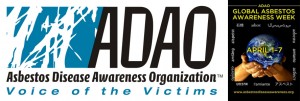To view all 7 days of Global Asbestos Awareness Week (GAAW) content, please click here.
7 FACTS FOR 7 DAYS: FACT TO SHARE TODAY: 55 countries have banned asbestos, but the U.S. and Canada have not. In 2012 alone, the U.S. imported over 1,000 tons of asbestos.
This day of Global Asbestos Awareness Week is dedicated to Mavis, a Mesothelioma Warrior in the UK. Click here to read her story, “Social Media and Mesothelioma.” Click here to read Mavis’ blog.
Posted on April 2, 2013
 By Dr. Richard Lemen, PhD, MSPH, Assistant Surgeon General, USPHS (Ret.) & Rear Admiral (Ret.)
By Dr. Richard Lemen, PhD, MSPH, Assistant Surgeon General, USPHS (Ret.) & Rear Admiral (Ret.)
Asbestos is a commercial term referring to a group of naturally-occurring fibrous minerals. Asbestos has remarkable durability and resistance to heat, properties conferring value in a wide range of products including building and pipe insulation, friction products including brake shoes, and fire-resistant bricks. Asbestos has been woven into fireproof cloth and incorporated into cement pipes used for water transport and into erosion-resistant cement roofing tiles. Unfortunately, asbestos fibers are also inhalable, and once inhaled, cause grave health risk, apparently because of their physical characteristics and bio-persistence in the body. Asbestos exposure causes a wide range of serious and fatal health conditions including pleural changes (plaques, thickening, breathlessness, loss of lung function), asbestosis (scarring of the lungs), cor-pulmonale (right sided heart enlargement and then failure), lung cancer, mesothelioma (cancer of the linings of the lung or abdomen), laryngeal cancer, gastro-intestinal cancers (including stomach, colon, recital), ovarian cancer, and is suspected of causing kidney cancers.
All asbestos fiber types have been found to cause all major types of asbestos-related disease, including the most commonly used form, chrysotile accounting for over 95% in the past and 100% in todays market. In reality, most asbestos use has involved either intentional mixing of different fiber types or inadvertent contamination of a fairly pure form with small quantities of another (natural contamination). In 2012, world production of asbestos was highest in Russia, China, Brazil, and Kazakhstan. While Canada has recently closed their asbestos mines other countries have been exploring reopening formerly closed mines such as those in Zimbabwe, once a major asbestos producer. Vast amounts of asbestos are still used in many developing countries where exposure is not limited to just workers, by also non-occupational groups including children. For these reasons and because scientists have not been able to determine a safe level of exposure to asbestos most industrial countries have banned its use. However, this has not been true for Canada or the United States where products can still contain asbestos.
Dr. Richard Lemen is the Assistant Surgeon General (retired) and serves as ADAO’s Science Advisory Board Co-Chairman.
Special thanks to our 2013 Platinum Sponsor, Motley Rice.


